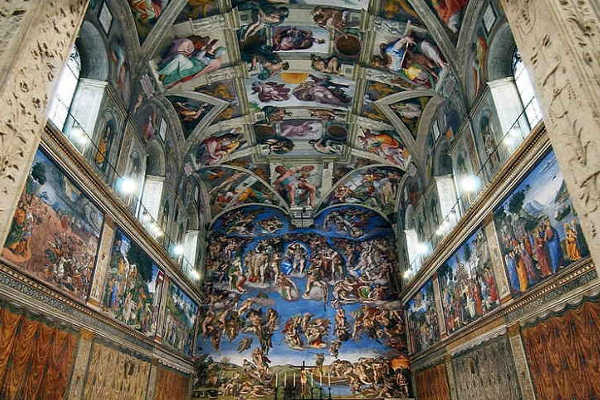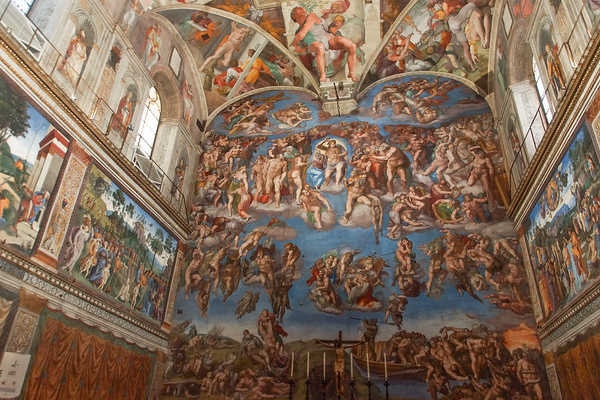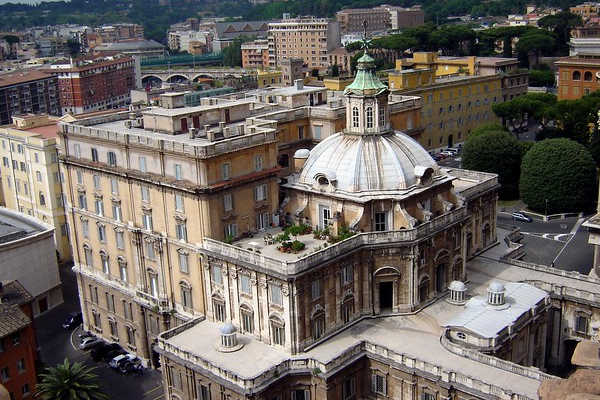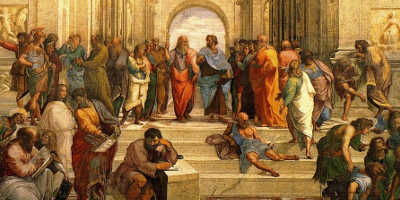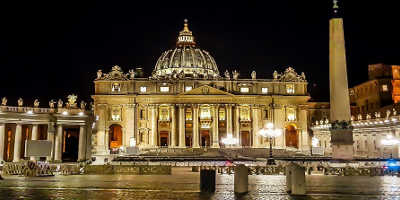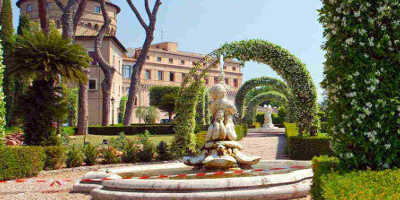Sistine Chapel, Vatican Museums
Undoubtedly one of the world’s most famous buildings, the Sistine Chapel is a testament to the immense skill of history’s greatest artists.
Located in the Apostolic Palace in the Vatican City, the Chapel draws thousands upon thousands of people each year and is one of the Vatican’s 54 Museums and Galleries. With the building having originally been named Cappella Magna, it was later renamed to The Sistine Chapel after Pope Sixtus IV.
History of Sistine Chapel
Before it became the Sistine Chapel in the 15th-century, it was called the Capella Magna. The renewal of this ancient building was commissioned in the 1470s by Pope Sixtus IV. This is how the name Sistine, came to be, as they named it after the previous Pope. Numerous artists, including Sandro Botticelli, Pietro Perugino, Domenico Ghirlandaio, Pinturicchio, and Cosimo Roselli completed the Chapel’s first paintings. Back during this time, the ceiling was not as we know it today, but a simple painting of the blue sky sprinkled with stars. Pope Julius II commissioned the extravagantly embellished ceiling in 1508 from the famous artist and sculptor, Michelangelo. Over the next few years, he created one of the most magnificent and well-known pieces of art in the world. The project lasted until 1512, and caused such a strain on Michelangelo, that it permanently damaged his eyesight.
The Papal Conclave
The most significant ceremony that takes place within these iconic walls is the Papal Conclave, which is the process that takes place to elect a new Pope. Though this is an important event for the entire Christian faith, the chapel’s artworks are what have made it such a famous attraction. While the murals on the walls display a level of artwork that only the greatest masters could create, the true highlight of the Sistine Chapel is Michelangelo’s incredible frescoes on the ceiling. Some of his more notable pieces being The Creation of Adam and the Last Judgment.
Michelangelo’s Frescoes
Though it may be the most iconic piece in the chapel, Michelangelo’s frescoes were the final additions to the exquisitely painted interior. Pope Sixtus IV oversaw Sandro Botticelli, Pietro Perugino, Pinturicchio, Domenico Ghirlandaio and Cosimo Roselli, the skilled renaissance painters as they worked on the walls up until 1508. Michelangelo began work on the ceiling in 1508 under Pope Julius II, but it wasn’t until 1535 that Michelangelo began work on The Last Judgment. When it was first unveiled, there was an outcry due to a large number of nude figures shown in a holy chapel. Many people believe that Michelangelo painted the ceilings whilst laid on his back however it is now known that he painted it whilst standing up on a large platform. At no point during the painting process could he see the ceiling and its painting in its entirety but, amazingly, he was able to create these vast masterpieces from a very short distance.
The famous ceiling is comprised of many sections, each separated by paintings of columns that look like part of the chapel’s architecture. Through the centre of the ceiling are 9 panels which depict various stories from the Book of Genesis. Beginning at one end is the creation of the sun, moon, and planets and the separation of the land and sea. Moving on are some of the most famous pieces including the ‘Creation of Adam’ in which God and Adam dramatically reach across to one another. The final panels show the stories of Noah. On either side of the panels are Sybils and prophets who are said to have foreseen the coming of Christ. Throughout the 1980s and 1990s, the frescos underwent extensive cleaning and now visitors can see the vibrant colours that Michelangelo chose to use.
On the far wall of the chapel, you will see the dramatic fresco entitled ‘The Last Judgement’. Michelangelo began painting this in 1535 when the church was in crisis. Pope Paul III commissioned the piece after his election in 1534 but during this time the Protestant Reformation was underway. Very different from the optimistic ceiling paintings, The Last Judgement has a far darker, more ominous feel to it as it depicts Christ overseeing the blessed rising to heaven and the damned being sent to hell. The tone of this fresco is said to reflect the insecurity and turmoil of the church at the time. The painting took 6 years to complete and is covered with intricately detailed figures that seem almost 3D. It is so significant-a-fresco that it has inspired and motivated many of history’s great artists to create their very best pieces.
The Architecture of Sistine Chapel
While the artwork on the inside is undoubtedly what makes this building so famous, there is much to be said for the architectural design as well. Giovanni of Dolci was the Architect assigned to create the three separate storeys and six-foot-high arched windows on each side of the building. The curious thing about this architect is that this masterpiece of a structure is the only work that he is remembered for.
The outside of the building is relatively modest when considering the artwork it contains. It has no external doorways because it is entered through the Papal Palace and the building itself is mainly visible only through the windows of surrounding buildings. The three storeys within are comprised of the vaulted basement, the main chapel with its frescoes and the third story that sits above the ceiling.
The Sistine Chapel is one of the world’s most exceptional attractions and, regardless of faith, witnessing these artworks in person is an experience like no other. A trip to Rome’s Vatican City would not be complete without stepping into this mesmerizing hall.

